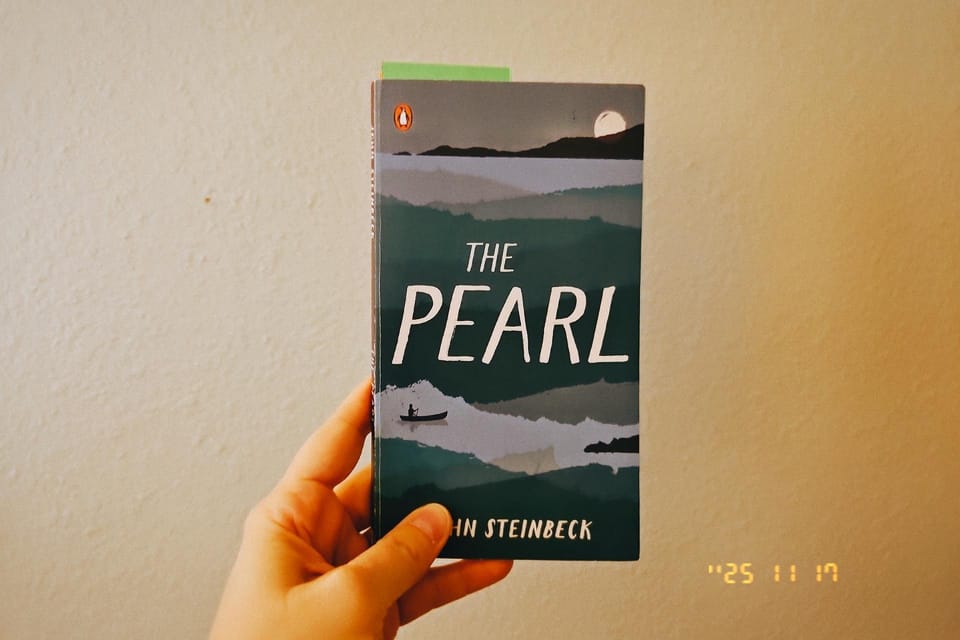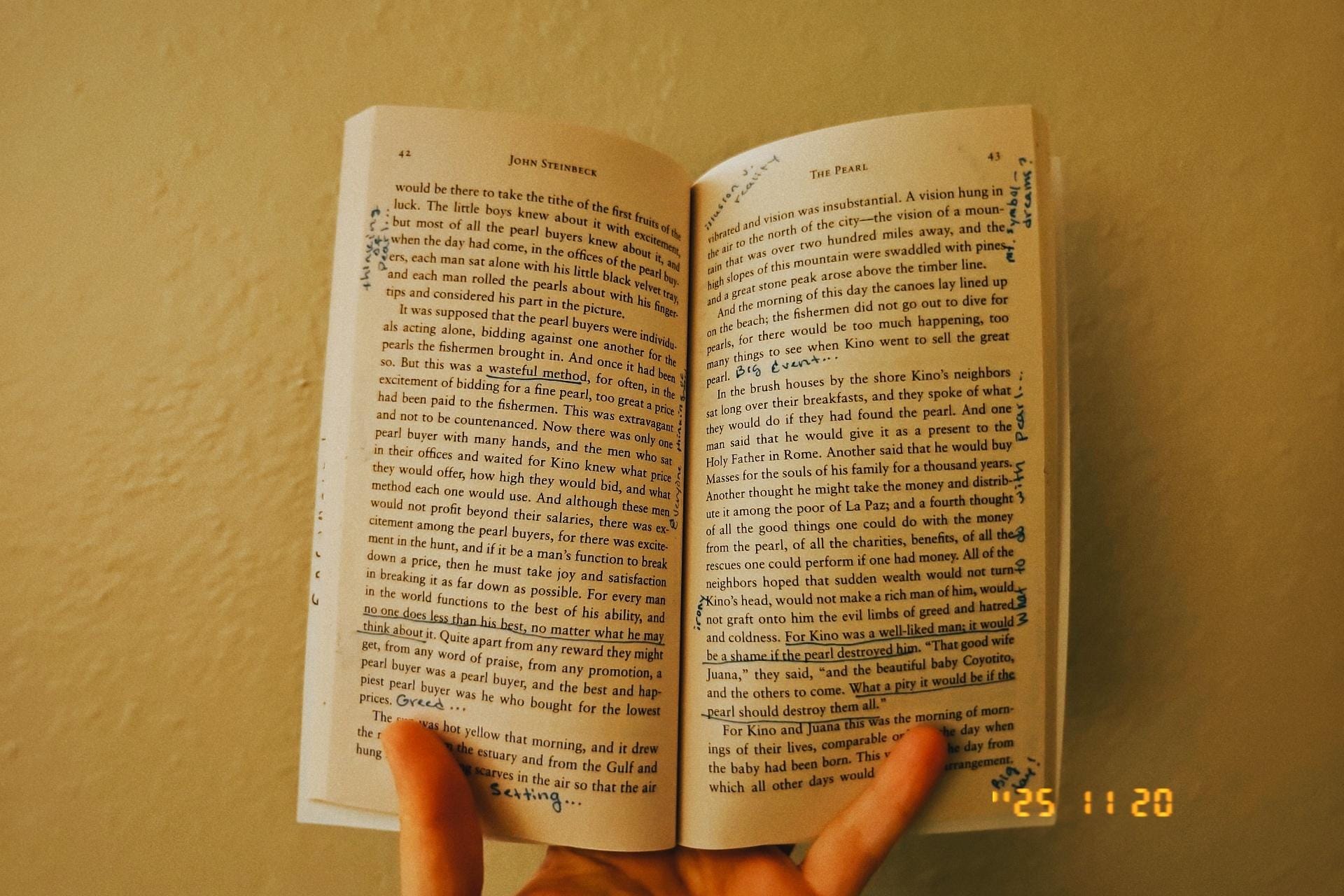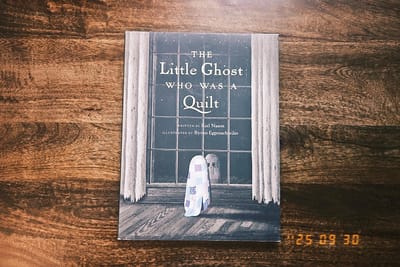The Pearl by John Steinbeck

Welcome to this unofficial meeting of our book club, Reading in Public.
We will start by reciting the Reader's Oath: I shall not poo poo on someone else's joy. The speed at which I read does not reflect my intelligence or character. It is simply a sign of my available time and overall exhaustion. I will DNF without mercy and tell everyone to read that one book no one else likes (because it was my favorite).


How The Book Came To Me
After reading Travels with Charlie years ago, I filed Steinbeck's work away in my mind as a catalogue of stories that I should read one day. While I have read one other work by Steinbeck, The Grapes of Wrath, I read it in high school, that was 30 years ago. I don't even remember what it's about. The word sharecroppers comes to mind.
Over the years, I've picked up a couple of his novellas at used bookstores and a well-loved copy of his tome East of Eden. Since their purchase, they have all dutifully sat on my shelf, waiting their turn.
The Pearl is one of those used bookstore finds. I got this copy for $.50. The cover was in good condition, and it's a novella, clocking in at just under 100 pages, making it a nice way to dip my toe into the catalog without fully immersing myself in what could turn out to be writing that I hate.
I recently read The Secret of Secrets by Dan Brown, and after a quick, adventurous read like that, anything else seems like a chore. I wanted to read something else, and I wanted it to be short so that it would simulate the quickness of the fast chapters by Dan Brown and James Patterson.
And that is how I chose The Pearl by John Steinbeck.
What's The Story About?
I didn't know exactly what this book was about when I bought it or even before I picked it up. I quickly skimmed the back of the book and it sounded like it might be an adventurous tale about sudden wealth. Maybe a fairytale of sorts. I wasn't sure.
Bookshop.org describes it this way:
Like his father and grandfather before him, Kino is a poor diver, gathering pearls from the gulf beds that once brought great wealth to the Kings of Spain and now provide Kino, Juana, and their infant son with meager subsistence. Then, on a day like any other, Kino emerges from the sea with a pearl as large as a sea gull's egg, as "perfect as the moon." With the pearl comes hope, the promise of comfort and of security.... BookShop.org
This description doesn't work. I describe the book like this: After Kino's son is stung by a scorpion, he and his wife go to the village doctor, but they are ignored because of their unfortunate financial circumstances and race. In an effort to improve their financial situation and get their son the treatment he needs, he turns to his trade: pearl diving. Fortune appears to shine on the little family when they find the "pearl of the world." But, is it actually fortune?
My Thoughts (And Some Spoilers)

By page 3 or 4, I thought that I had made a mistake. I thought that Travels with Charlie was a fluke. Maybe I liked it because it was non-fiction. What if I'm not a person who likes Steinbeck's fiction? Maybe, I shouldn't have jumped into classic literature right after reading a fast-paced, action-adventure novel?
I found the beginning of the story to be incredibly slow. It felt syrupy thick. I've often described classic literature novels as being like walking through oatmeal. Difficult, but rewarding. Even if you don't like the classic literature you're reading, you come out the other end of it knowing a little bit more about yourself as a reader.
Despite the slow start, I kept reading. As I was reading the story, I didn't feel like I was into it, but when I put the book down, I immediately wanted to pick it back up.
As I previously mentioned, this is a short book. It comes in at just under 100 pages. Despite that, it took me three days to read it. I read a page or two during breaks at work for a couple of days. Then Thursday night, while my partner and step-person were immersed in math homework, I curled up in my reading chair and finished the book.
I'm still not sure if I liked it.
My liking it or not liking it doesn't mean the book is good or not good. The writing is superb. The story isn't the type I typically enjoy. So when I say I'm not sure if I like it, that's why.
Here is where the spoilers come in. If you want to step away, now would be a good time.
This book does come with trigger warnings. This book contains domestic violence, racial slurs, and harm to a child.
This book got dark insanely quickly. Right when you think the book is just a long love letter to a simpler life, a scorpion stings a baby.
That's the kind of thing I don't need to read. I don't find it entertaining. I don't need to be on the emotional roller coaster, page after page, reading about sick children or mourning parents. I don't find that kind of thing entertaining.
The mother quickly takes action. It is unclear if she solved the problem, so they took the baby to a doctor. The doctor is a racist and classist asshole. So, we hate him.
The doctor refused to see them, so in an effort to gain enough riches to be seen by the doctor, the main character, Kino, plies his trade in a canoe to go pearl diving.
This is where the story gets weird. It becomes almost a monkey-paw style story without the three wishes. The moment the pearl comes into Kino's life, his life is ruined. Just ruined. I won't spoil any more of the book here, but I can tell you this: it doesn't end on a high note, friends.
Spoilers over.
While this book is dark and a downer, to say the least, it is very successful. Here's why: how often have you read a book, put it down, and stopped thinking about it? How many books have you read where you cannot recall the main character's name?
Kino. Juana. Coyotito. You'll remember them all. You'll have pictures of their lives in your head, clear enough to be a memory.
If I had been made aware of these trigger warnings, I would not have read this book. I certainly wouldn't have purchased it.
It's hard to find classic literature that doesn't contain offensive material, given the times we live in. That said, you can't watch the news without encountering offensive material, given the times we are living in.
Literature scholars, Steinbeck researchers, and writers in training: you may want read this book.
Everyone else, read the trigger warnings that I've listed above and proceed with caution.

Want to Read The Pearl?
→Support this blog and your local bookstore by shopping with Bookshop.org https://bookshop.org/a/94915/9780140177374
→Get a copy from Amazon https://amzn.to/47V6hX3
Join the Free Mailing
Every other Sunday, the Sunday Dispatch brings you digital postcards, missed posts, and must-see updates.





Member discussion